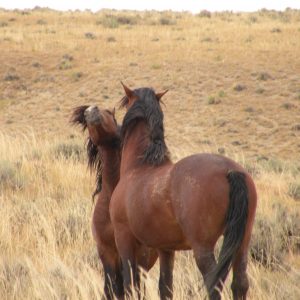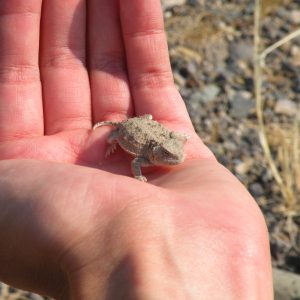- Mustang rivalry
- Mustangs on the run
- Dinky little horned lizard
Work continues, with different tasks practically every day. I love variety.
As the weather continues to transition into Fall and my amphibian searching season is winding down, I will increasingly be doing things like fence type inventories, re-spacing fence wires, making a last minute seed collection, other office work involving GIS mapping and sorting through eagle and vegetation data, and helping other people in the office with their work. Some of the work with other people has included trail assessments, evaluating streams for proper functioning condition, and weed spraying.
Yesterday I was fortunate to accompany the wild horse specialist on her quest to see if a mustang mare had foaled yet. We saw lots of horses and a few foals, though not from the particular mare we were checking up on. I was surprised to learn that all the BLM horses have names. Most are named by the USGS (US Geological Survey), but I guess I had expected that they would all have code numbers or something so as to remain distanced and objective with their management. Talking to the wild horse specialist has been very educating; I have always wondered about the management methods of the mustangs and what exactly the controversy over their presence on the land and their management was all about. I never really knew how I felt about the matter, but now that I have an understanding of the various viewpoints and issues involved in it, I have developed an informed opinion. What that opinion is I think I will keep to myself for this entry, but this realization does highlight the value of learning from a diversity of people in the office. You never know what kinds of useful stuff you’ll pick up on, and it’s great networking for future jobs and references, not to mention friends.
I am still waiting to hear whether or not there will be funding to extend my internship, so I have been trying to plan for my next job, but if they can find funding I would like to stay in Cody a while longer. It’s been a great a experience, and I like the place and people. I already feel that the end is quickly approaching, and it makes me a little sad. I know that I will be reluctant to leave, but for now I can’t do anything but press on and learn everything I can squeeze out of the whole experience. There is still plenty of interesting work to be done, and an intern couldn’t ask for more.






















